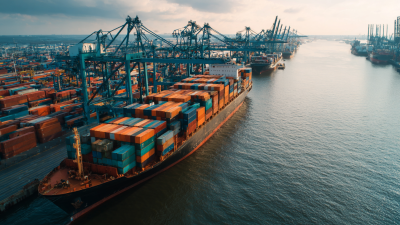Unlocking Global Trade How Cross Border Bearing Procurement Services Revolutionize Your Supply Chain
In the rapidly evolving landscape of global trade, efficiency and innovation are paramount to staying ahead. "Cross-Border Bearing Procurement Services" have emerged as a pivotal solution, revolutionizing how businesses source critical components across international borders. According to industry expert Dr. Michael Reynolds, "The future of supply chains hinges on the ability to streamline procurement processes, and cross-border services are leading the charge in creating new opportunities."
This transformative approach to procurement not only enhances the speed and reliability of sourcing bearings but also allows companies to tap into a broader market, ultimately driving down costs and improving overall supply chain dynamics. Businesses are now leveraging digital technologies combined with strategic cross-border services to navigate complexities and elevate their operational capabilities.
As we delve into the intricacies of "Cross-Border Bearing Procurement Services," we will explore key strategies and tips for effectively integrating these services into your supply chain. By understanding the critical role these services play, companies can unlock new levels of efficiency and competitiveness in an increasingly interconnected world.

Understanding Cross-Border Bearing Procurement: A Gateway to Efficient Supply Chains
In the realm of global trade, cross-border bearing procurement services are increasingly recognized as a pivotal gateway to achieving efficient supply chains. With the automotive bearing market projected to generate revenues of USD 38.31 billion by 2031, growing at a CAGR of 6.12% from 2024 to 2031, it is evident that the demand for streamlined procurement processes is on the rise. These services facilitate not just the acquisition of quality bearings but also enhance operational agility and reduce lead times, thereby significantly impacting production cycles.
The advent of advanced technologies, such as artificial neural networks, has further revolutionized cross-border e-commerce and supply chain management. By leveraging predictive analytics, businesses can accurately forecast sales trends and optimize their supply chains in real-time. Recent JD MRO data highlights a staggering 180% year-over-year increase in procurement among industrial manufacturing enterprises in China, demonstrating the robust recovery and growth potential in cross-border logistics. This exemplifies how efficient and strategic procurement services can unlock new avenues for businesses, allowing them to navigate complex international markets with confidence.
Unlocking Global Trade: How Cross Border Bearing Procurement Services Revolutionize Your Supply Chain
| Dimension |
Overview |
Benefits |
Challenges |
| Procurement Cost |
Cost analysis of acquiring bearings from different countries. |
Potential for reduced costs through competitive pricing. |
Variability in shipping costs and taxes. |
| Lead Time |
Time taken from order to delivery across borders. |
Faster access to global suppliers can improve turnaround times. |
Customs delays may increase overall lead time. |
| Quality Assurance |
Standards and certifications followed by suppliers internationally. |
Access to diverse suppliers with high-quality products. |
Difficulty in ensuring consistent quality across regions. |
| Regulatory Compliance |
Understanding international trade laws and regulations. |
Reduced risk of legal issues through diligent compliance. |
Complex regulations can complicate procurement processes. |
| Supplier Relationships |
Building trust with overseas suppliers for better collaboration. |
Strengthened partnerships can lead to better terms and reliability. |
Cultural differences may impact partnerships. |
Leveraging Technology in Cross-Border Procurement: Trends and Tools for Success
In today's interconnected world, cross-border procurement is transforming the landscape of global trade, especially through the lens of technology. Leveraging innovative tools, businesses can streamline their supply chain processes and enhance efficiency when sourcing bearings and other critical components from international markets. Platforms that facilitate real-time data sharing, e-procurement systems, and supply chain management software empower companies to make informed decisions, ensuring they remain competitive and responsive to market demands.
Emerging trends such as artificial intelligence and blockchain are at the forefront of this revolution, providing transparency and security in cross-border transactions. AI-driven analytics can predict demand fluctuations, helping businesses adjust their procurement strategies accordingly, while blockchain technology ensures traceability and reduces fraud risks associated with international trade. By embracing these advancements, companies not only optimize their supply chains but also foster stronger partnerships across borders, paving the way for sustainable growth and innovation in their operations.
The Impact of Global Supply Chain Disruptions on Bearing Procurement Strategies
In recent years, global supply chain disruptions have highlighted the critical role of robust bearing procurement strategies. According to a report by McKinsey, the pandemic-induced disruptions have led to production delays and increased costs, with approximately 75% of companies experiencing significant supply chain challenges. These disturbances have compelled organizations to reevaluate their sourcing practices, emphasizing the need for resilience in their supply chains.
Adopting cross-border bearing procurement services can effectively address these disruptions. A study from Deloitte indicates that companies leveraging global procurement strategies can reduce costs by up to 20% while enhancing supply chain agility. By tapping into international suppliers, businesses can diversify their sources, mitigate risks associated with regional disruptions, and improve lead times. This strategic approach not only fortifies the supply chain against unforeseen events but also positions companies to act swiftly in responding to market demands.
Impact of Global Supply Chain Disruptions on Bearing Procurement Strategies
This chart illustrates the monthly changes in bearing procurement lead times and costs due to global supply chain disruptions. The data reflects the increasing lead times and costs from Q1 2020 to Q4 2021.
Analyzing Cost Savings: How Cross-Border Services Enhance Bearing Supply Chain Efficiency
In today's global marketplace, cross-border bearing procurement services are transforming supply chain dynamics and delivering significant cost savings for businesses. According to a report by the International Bearing Association, companies that utilize these services can reduce operational costs by up to 20%. This is primarily due to access to a wider array of suppliers, competitive pricing, and innovative logistics solutions that streamline the procurement process.
Furthermore, a study conducted by McKinsey & Company highlights that organizations engaged in cross-border procurement demonstrate improved supply chain efficiency by approximately 30%. The integration of advanced technologies such as blockchain and IoT in monitoring shipment statuses and ensuring quality control facilitates real-time decision-making, which is crucial in minimizing delays and enhancing inventory management. As a result, businesses can better respond to market demands and reduce the risk of stockouts, ultimately leading to increased customer satisfaction and loyalty in an ever-competitive environment.
Compliance and Risk Management in Cross-Border Bearing Procurement: Best Practices to Follow
In the realm of cross-border bearing procurement, compliance and risk management have become paramount for companies aiming to streamline their supply chains. According to a report from the International Trade Centre, approximately 25% of businesses cite compliance issues as a significant barrier to international trade. To effectively navigate these challenges, companies should implement best practices that not only mitigate risks but also enhance operational efficiency.
One essential tip is to stay updated on the regulatory frameworks of each country involved in the procurement process. Regular audits and compliance checks can significantly reduce the risk of non-compliance, ultimately avoiding costly penalties. Additionally, fostering strong relationships with local suppliers can provide valuable insights into regional regulations and market dynamics, enabling better decision-making.
Moreover, leveraging technology can enhance visibility and tracking throughout the procurement process. Implementing digital supply chain management systems allows businesses to monitor compliance in real-time and address any potential issues proactively. This technological integration not only safeguards against risks but also ensures a smoother, more reliable supply chain, enhancing overall business resilience in a competitive global market.

Home
Products
Industrial Bearings
Deep Groove Ball Bearings
Self-Aligning Ball Bearings
Angular Contact Ball Bearings
Cylindrical Roller Bearings
Taper Roller Bearings
Spherical Roller Bearings
Bearing housing or Accessories
Miniature Bearing
Thrust ball bearing
Radial Spherical Plain Bearing
Pillow Block Bearing
Needle Roller Bearings
Automotive Bearings
Agricultural Bearings
Special Material Bearings
Industry Application
About Us
News
Contact Us









